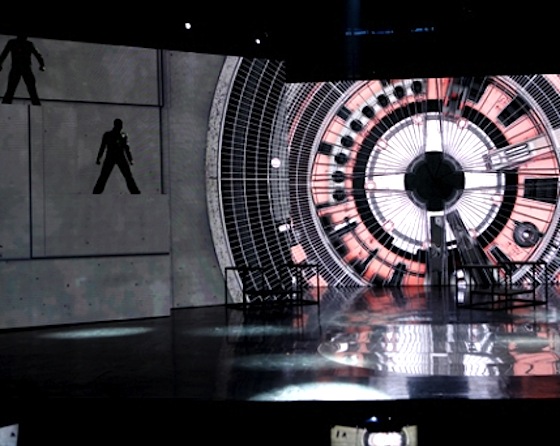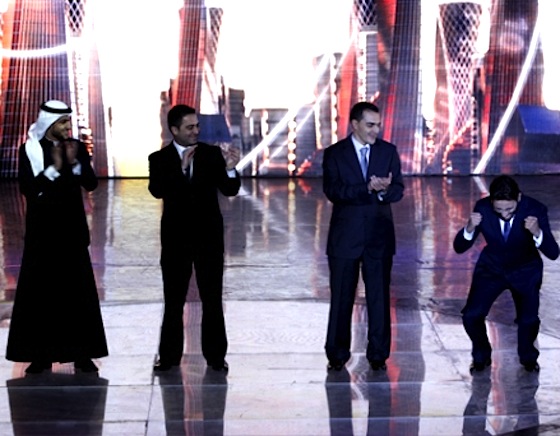 The Stars of Science reality TV show would be so much more exciting if it spurred sustainable ideas.
The Stars of Science reality TV show would be so much more exciting if it spurred sustainable ideas.
Perhaps we shouldn’t begrudge the Arab World’s first serious reality TV show, particularly since Stars of Science was designed to encourage more youth in the region to pursue science and technology. But it’s hard to turn a blind eye to some of the inventions coming from this show when the Qatari government is spending tens of millions of dollars to produce it.
Like Abu Dhabi, where Masdar City – the Middle East’s most ambitious study in sustainable development – was born, oil-rich Qatar is building a lagging knowledge base for the day that oil runs out, but that’s where their similarities end. While Abu Dhabi has been voted the “greenest” of Gulf countries, Qatar’s western-ish televised competition has yet to produce genuinely sustainable innovations. One woman, 15 men
Out of 7,000 applicants, only 16 budding scientists in the Arab World were selected to compete in Stars of Science. One of them was Sereen Sharairi, a Jordanian biomedical engineer and the only female contestant, and the rest were men from Egypt, Syria, Kuwait, Lebanon, Tunisia and elsewhere.
Of the sixteen, only five contestants were chosen to present their business plans to fierce judges – modeled after American Idol’s sometimes sarcastic and soul-destroying Simon Cowell – after each product’s engineering and technical viability had been established.
Their ideas are genuinely groundbreaking for a region that has long neglected its former scientific glories, and at least one invention had a humanitarian component to it, but mostly they reveal a disturbing absence of any kind of green vision.
 Where’s the green vision?
Where’s the green vision?
Mohammed Al-Chaari from Tunisia devised a wireless charging device that would provide battery juice to inefficient robots that inspect pipelines. He told Wired that when the show was done, he hoped to move into the nuclear industry instead.
Bilal Al-Dukhan from Syria, the first of the five final contestants to be pushed off the show because of an unrealistic business plan, designed a mold that would produce cement blocks in one day instead of six. Although this improved efficiency would have led to a reduction in energy consumption, it would also have spurred rapid manufacture of one of the most unsustainable building materials on earth.
Mohammed Al-Rifal from Kuwait designed an ironing robot. While the region’s women might have appreciated a reduction in their work load, his invention seems to us like an unnecessary gimmick in a world so full of junk it’s actually floating in space.
Ziad Sankair from Lebanon put people at the forefront of his vision by coming up with a wearable heart monitor that can predict if a person is going to have a heart attack with a realtime EKG monitoring device. He was also one of the few contestants to have a clever, realistic business plan that stumped the jury’s criticisms.
Although the winning design by Haytham Dsouki from Egypt is clever and what Wired called “neatly packaged,” it definitely wasn’t designed with sustainability in mind. Instead, the touch-sensitive plastic stickers embedded with tiny circuits turn any surface into a digital interface – a la iPhones, iPads, etc.
Dsouki envisions that all of Egypt’s future public bathrooms will be equipped with these tiny interfaces. Conceptually, it would be easy to use this technology to control water consumption but mostly – as Wired explains it – “this Arab, a kid from a working-class Cairo neighborhood, had come up with an invention that wouldn’t feel out of place in an Apple store.”
And for it, he received $300,000 in prize money.
The 2011 show is done, but we hope that with Qatar’s controversial 2022 solar-powered World Cup on the horizon, not to mention growing signs that unsustainable human behavior is killing the planet, the 2012 contestants will put on their green caps.
:: We learned about Stars of Science from a full-length Wired feature that is absolutely worth reading.
All images via Stars of Science
More on Science and Technology in the Arab World:
7 Amazing Clean Tech Projects From the Arab World
Sharjah Students Make Renewable Energy From Noise
Masdar and Siemens Team up to Develop Sand-Resistant Solar Panels




Given how tough the selection process is for any of the candidates who make it on the show, it would depend of what you define as winning as anyone who makes it as one of the 16 candidates has already cut through and marked themselves and their ideas out from the crowd. The TV competition is an extremely challenging environment for any idea to make it to the end due to a number of factors however our experience has been that any time a green project makes it as one of the 16 projects, we have an abundance of support from places that range from the Ministry of the Environment to private sector companies. We hope that stars of science as well as all the other
initiatives that support young Innovators will continue to encourage new approaches to the challenges that face society
Thank you for your perceptive article about our program Stars of Science and for raising some important points.
As you mentioned, our program aims to encourage the next generation of Pan Arab innovators who apply in their thousands to be on the program. Over the past 4 seasons we have had a number of innovations that focused on sustainability /green issues that ranged from Solar powered tents as per your article last year on Green Prophet, tp Educational & automated recycling bins targeting children & creating fuel from overactive Algy. We have featured several of our fast fact reports on various green and sustainable Innovations from sustainable energy production to cleaner living and recycling.
We strive to continuing our efforts to support the next generation of Arab innovators and look forward to seeing young innovators joining us in future seasons with even more ideas on sustainable innovations.
Thank you so much for responding and for bringing our attention to the sustainability initiatives that I neglected to point out. Can you maybe tell us why none of these “greener” designs have won? Are these engineering flaws, or does this represent something about our region’s overall priorities?